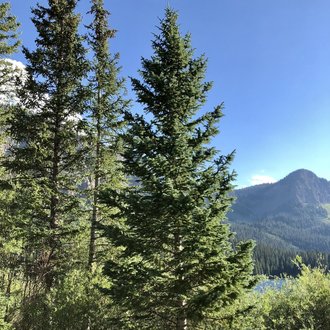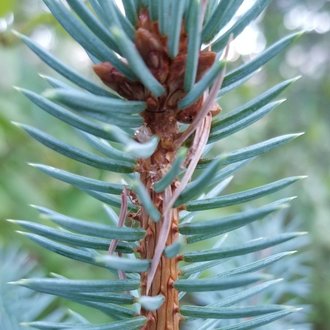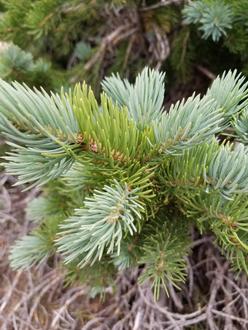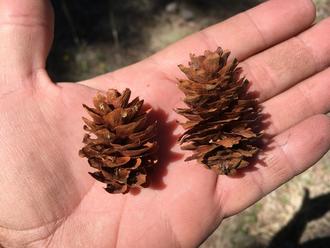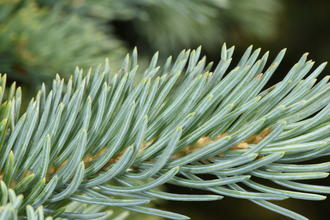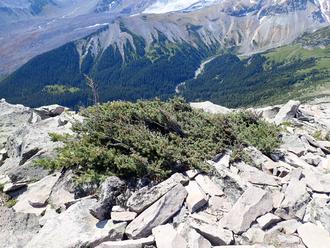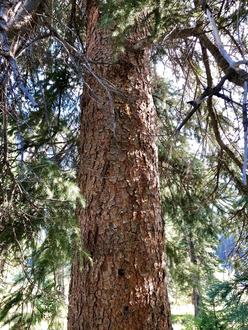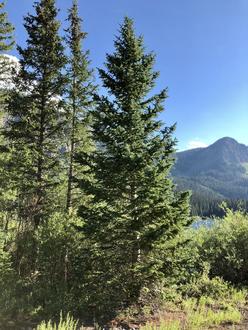Engelmann Spruce (Picea engelmannii Parry ex Engelm.)
Also known as Englemann spruce (Misspelling).
↑Summary
A large spruce of mid-to-high elevations in the Cascades and Rockies.
↑Range - Expand
| Legend | Color |
| Native | |
| Native or Not Present |
This tentative map is based on our own research. It may have limited data on Canada and/or Mexico, and there is some subjectivity in our assignment of plants as introduced vs. expanded. Read more in this blog post.
Although this plant occurs somewhere in each of these regions, it may only occur in a small part of some or all of them.
↑Similar Plants
↑Habitat
Found in the highest-elevation and coldest forests of western North America, regions with long, cold winters, heavy snowpack, and brief, cool summers.
Throughout most of its range, limited to moist sites, but at the tree line, also found on dry sites. At mid elevations, more common on cooler north- and east-facing slopes, along alluvial terraces, and near seeps.
Extends to the lowest elevations only where local cold air drainage creates cooler microclimates, such as depressions along major valleys.
In the south of its range, limited to elevations over 8,000 feet (2,438m) but in the north, extends as low as 2,000 feet.
Found on a variety of soil types; grows best on deeper, well-drained loamy sands or silts, or clay loams. Also found on alluvial soils where the water table is near the surface. Found on, but grows poorly on coarse sands, rocky, and gravely soils, heavy clay soils, and water-saturated soils.
Usually found in later successional stages of forests; on some sites, following a disturbance such as fire, Engelmann Spruce may take over 100 years before it even establishes seedlings. However, at higher elevations, it may establish immediately after disturbance, especially if a seed source of adult trees is nearby.
Usually limited to sites sheltered from fire. At the highest elevations, rocky terrain, and the absence of fuel usually prevents the spread of fire, and at mid-to-low elevations, the cooler, moister sites tend to inhibit fire.
↑Life Cycle
Seedlings establish best on exposed mineral soil; survival is poor on thick organic matter or litter because, in this species habitat, these substrates dry out quickly. However, at the highest elevations, some litter may protect seedlings from frost heaving or heavy summer rains.
In the south of this species range, where light levels are higher, seedling survival is poor on exposed sites, and seedlings require some shade to get established.
This is a slow-growing species, often growing around 1 inch per year for the first ten years. Trees grown on favorable sites in open conditions can begin producing seed between 15 and 40 years of age, but trees establishing under a closed forest canopy grow much slower and take longer to produce seed. In shade, 100-year old trees may be only 3-5 feet tall.
Seed production is irregular, with good crops tending to be produced at 2 to 5 year intervals. Most seed is dispersed by October at the latest, but small amounts of seed continue to fall through winter, where it sometimes travels further on the surface of crusted snow.
Seeds remain dormant through winter; most seeds germinate 2-3 weeks after snowmelt. A small portion of seeds germinate in summer, in a second wet season, or germinate in the spring of the second year. However, there is not appreciable long-term seed banking.
Engelmann spruce is relatively vulnerable to fire. Large trees, especially those on sheltered sites, can occasionally survive low-intensity fires, but usually fire of any intensity will kill this species. The combination of poorly-insulated bark, highly flammable resin, shallow root system, low-growing branches, tendency to grow close to other trees, flammable foliage, and lichen growth on the branches, all contribute to this species' poor survivability in a fire.
Dominant canopy trees routinely live 350-450 years, and trees 500-600 years old are relatively common.
↑Related Plants
Closely related to white spruce (Picea glauca), with which it hybridizes in the north where their ranges overlap.
↑Links & External Resources
• Engelmann Spruce | The Wood Database (About This Site)
• Engelmann Spruce | Fire Effects Information System (FEIS) (About This Site)
• Picea engelmannii (Engelmann Spruce) | USDA PLANTS Database (About This Site)
• Engelmann Spruce | iNaturalist (About This Site)
• Picea engelmannii (Engelmann Spruce) | Missouri Botanical Garden Plant Finder (About This Site)
• Engelmann Spruce | Virginia Tech Dendrology Factsheets (About This Site)
• Engelmann Spruce | Silvics of North America (About This Site)
• Picea engelmannii | Biota of North America Project (BONAP) (About This Site)
• Picea engelmannii | NatureServe Explorer (About This Site)
• Picea engelmannii | Flora of North America (About This Site)



